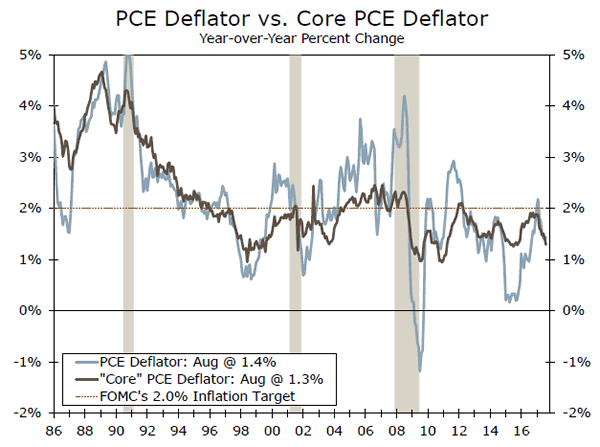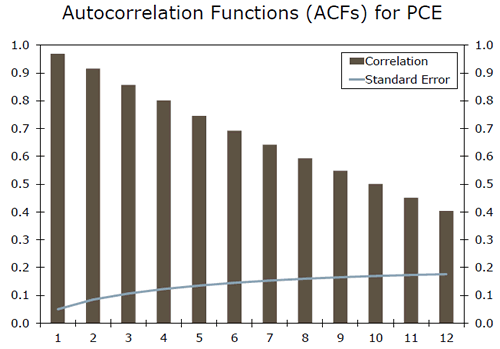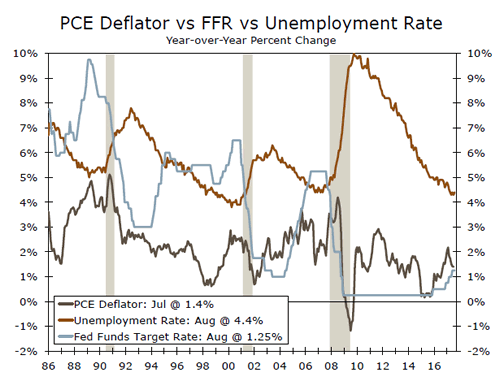"It ain’t what you don’t know that gets you into trouble. It’s what you know for sure that just ain’t so." – Mark Twain
Executive Summary
The Federal Open Market Committee’s (FOMC) 2 percent inflation goal is often targeted by adjusting the FOMC’s monetary policy stance. The implicit assumption (or the invisible hand) behind the 2 percent inflation target is that the inflation rate is mean-reverting at the 2 percent rate. However, this assumption requires further inspection and raises questions regarding the possibility that the inflation rate would deviate from the target rate. Moreover, what is the behavior of above-/below-target inflation? Are these deviations temporary or permanent in nature?
An inflation target plays a critical role in the FOMC’s monetary policy decision making process. Therefore, testing, instead of assuming, to determine if the PCE inflation rate is mean-reverting is crucial for decision-makers.
Our statistical analysis suggests that the PCE inflation rate may be mean-reverting, although the evidence is tenuous. So, can we assume inflation is mean-reverting, and what level of confidence do we have? A mean-reverting series, by definition, can fluctuate from its mean but eventually returns to some average value. The next challenge is to estimate the pace of adjustment. That is, how long does it take the inflation rate to return to the target rate after deviating from it? And does the PCE inflation series have a persistence/autocorrelation problem?
Why is persistence/autocorrelation of the inflation rate a concern for decision-makers? Inflation persistence has crucial policy implications as a consistently below-/above-target inflation rate would suggest an accommodative/restrictive monetary policy for an extended period of time, all else constant. Therefore, a very slow pace of monetary policy normalization would be a possible result if below-target inflation persists for an extended period of time.
To Anticipate the Results
Our analysis indicates that inflation has an autocorrelation problem. Put differently, when the inflation rate deviates from the target rate, inflation takes a long period to get back to the 2 percent target rate. One major reason is that the current inflation rates are highly correlated with the past values (coefficients are very high, close to one). Therefore, the inflation rate would take a longer time to get back to the target rate than if autocorrelation were not present. For example, during the period from November 2008 to August 2017, the inflation rate was below the 2 percent target for 86 out of 106 months.
Furthermore, persistently low inflation may not only affect interest rates but also other variables. One of them is the unemployment rate, as the Phillips curve suggests an inverse relationship between the unemployment rate and inflation. The recent debate about the Phillips curve status is reflective of the characteristic that the original Phillips curve does not allow for an autocorrelation problem. Persistently low inflation may also explain part of the slower wage growth in recent years. Low inflation rates may reduce business production and their ability to raise prices, and, thereby, may affect profit margins in a low-productivity economy. The wage-price spiral may have lost its speed as well.
The 2 Percent Inflation Target Rate: Is Inflation Mean-Reverting?
Statistically, if a series is mean-reverting then that series will move around its mean (the FOMC is assuming the 2 percent is the mean) and deviations from the mean (higher/lower inflation periods) are temporary in nature. As a policy model, the FOMC’s 2 percent target assumes, implicitly, the inflation rate is mean reverting.
We live in a constantly changing world and need to test, instead of assume, that the PCE inflation rate is mean-reverting. We apply a unit root test (ADF test) to find out if the inflation rate is mean-reverting.1 The PCE deflator (year-over-year percent change) is the preferred inflation measure of the FOMC, and, thereby, we utilize that series in our analysis, Figure 1.

For the 1984-2017 period, we find the inflation rate is mean-reverting and the mean is 2.3 percent. In the next step, we apply the state space approach to test the possibility of a structural break in the inflation rate series. If we find a structural break in the inflation rate and the break coefficient is positive (negative), then that indicates the inflation rate has shifted upward (downward) since the break date. We found two breaks – one positive and the other negative. Both breaks represent the price swings during of the 2008-2009 financial crisis. Therefore, the inflation path temporarily shifted and then returned to the long run average – a typical behavior of a mean reverting series.
Autocorrelation: When Slow and Steady May Not Be Enough to Win the Race
If a series is mean-reverting, the fluctuations from the mean are temporary – but fluctuations still exist. Thus, while inflation rates may deviate from the mean, it is crucial to find out the pace of adjustment. How long does it take inflation to get back to the mean? PCE inflation persistently above or below the 2 percent target rate is not ideal for the FOMC. Both of these scenarios would ask for an extended period of a particular monetary policy stance. One way to test if the inflation rate series has a persistence problem is to test for an autocorrelation. The inflation data having an autocorrelation problem would indicate that the farther the inflation rate deviates from the target rate, the longer the inflation rate would take to return to the 2 percent target rate.
We estimate autocorrelation functions (ACFs), and the estimated correlation coefficients are nonzero, statistically, for first 12 lagging months, Figure 2. Furthermore, if the estimated coefficients are non-zero then that indicates the underlying series has the autocorrelation problem. We found that the PCE inflation series is autocorrelated, which indicates current inflation rates are highly correlated with its past values (coefficients are very high, close to one). Therefore, the inflation rate would take a longer time to get back to the target rate. During the period from November 2008 to August 2017, the inflation rate was below the 2 percent target for 86 out of 106 months. This gives reason for the market’s expectation that the pace of monetary policy adjustment would be gradual as well.

Why is the persistence/autocorrelation of the inflation rate noteworthy for monetary policy decision-makers? Inflation persistently below the target would indicate an accommodative monetary policy for an extended period of time, all else constant. Therefore, a very slow pace of the monetary policy normalization is a possible result of persistently lower inflation.
Final Thoughts: The Invisible-hand may need a Boost
The mean-reverting along with lack of autocorrelation/persistence assumptions may be the ‘invisible hand’ behind the 2 percent target rate. However, our findings of autocorrelation suggest the invisible hand may need a boost. Moreover, the autocorrelation/persistence problem has broader implications for decision makers, as persistently lower inflation may not only affect interest rates but also other variables. One of them is the unemployment rate, as the original Phillips curve does not anticipate an autocorrelation problem, Figure 3. A persistently low inflation rate may also explain part of the slower wage growth in recent years. The persistently low inflation rate may reduce business production and their ability to raise prices and thereby may affect profit margins in a low-productivity era. The wage-price spiral may have lost its speed as well. Therefore, the invisible hand behind the inflation rate may need a boost.














